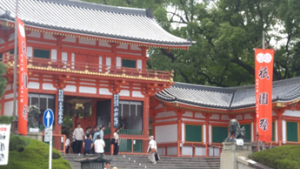Gravity(Attraction) of KyotoⅥ Konchiki Chin resonates with the heavens and the earth. The 432 Hz gong, flute, drum and music of the Gion Festival.
Yoshie Doi

Yasaka Shrine West Tower Gate, west end of Shijo Street, photographed July 2024
July in Kyoto is synonymous with the Gion Festival. The Gion Festival continues throughout the month of July, also known as Hamozuki. The food culture and atmosphere of the city are dominated by the Gion Festival. At Karasuma Station on the Hankyu Railway, which I use every day for my commute, the Gion Festival’s music, “Konkonchikitchin,” can be heard on the station platform during this time, adding to the excitement of the festival.
Yasaka Shrine is located at the eastern end of Shijo Street, and Matsuo Shrine is located at the western end. Both enshrines the gods of the mountains and the sea. The deities worshipped at Yasaka Shrine are Susanoo-no-Mikoto, Kushinadahime-no-Mikoto (the god of bountiful harvests), and Yahashira-no-Mikoto. The gods protect both the east and west sides of Shijo Street, the center of Kyoto.
The deity enshrined at Matsuo Taisha Shrine is Oyamagui-no-kami, the god of mountains, agriculture, and sake brewing. Also enshrined is Ichikishimahime-no-mikoto, one of the three Munakata goddesses, known as the god of water and maritime transport.
The Gion Festival, where the music resonates across the mountains and sea, the heavens and the earth, is a soothing experience that aligns the festival frequency with nature. Gong and flute are used to reach the heavens.
The Japanese idea that humans coexist with nature as part of it is based on the idea that the frequency of nature is 432Hz, and many natural sounds, such as the sound of wind, water, and birds singing, are 432Hz. This is said to be the frequency that makes people happy, and pianist Nobuyuki Tsujii is well aware that this sound heals the body. Mr.Tsujii only plays Steinweiler’s 432Hz piano. He must be able to sense the frequency.
Apparently all of the early European classical music was composed in 432Hz. Mozart’s music in particular is based on Pythagorean tuning, which is said to be the origin of Do-Re-Mi. This tuning is a pursuit of a better tone, and it is soothing to the soul. It is said to be the sound of the harmony of the universe.
The Sandai Jitsuroku records that music was played at the Goryoe ceremony held at Shinsen-en in 863 during the Heian period. An illustration also shows that “the chanting of flute, gong and drum is called Gion-bayashi.” It is likely that Gion-bayashi is responsible for pacifying evil spirits. Music is an integral part of festivals, and it is said that in ancient times, metallic sounds were used to communicate with the heavens. Even today, this sound is used to communicate with the heavens in Tibetan esoteric Buddhism and other religions.
The bells on New Year’s Eve are also made of metal, and although the frequency seems to vary slightly depending on the temple, they are a sound that resonates with the souls of Japanese people and have a pleasant resonance. About the acoustics (please also refer to our previous blog for more information on the Gion Festival)
The end of document
Translated by Masami Otani
